All About Lizard Terrariums

A suitable terrarium is the key to a comfortable lizard living at home. Numerous factors must be considered when choosing or designing it, from size and shape to ground and lighting.
Views
There are enough varieties of terrariums for lizards, differing in purpose, structure, and appearance.


By material
It is customary to make a reptile dwelling from ordinary glass, plastic or organic acrylic glass. The latter material is the most preferable: its high strength is the key to a long service life. A regular glass terrarium can be damaged quite quickly, and this fragile material is also quite difficult to work with. The PVC container also has disadvantages - the surface of the soft plastic quickly loses its transparency, becoming covered with scratches from the claws of lizards.
The structure itself may or may not have a frame. It is recommended to take large models with additional reinforcement, since the frame will prevent wall deformation.



To size
The size of a reptile's habitat should be appropriate for its size and meet the needs of the animal. For example, for tree lizards, small vertical terrariums are more suitable, the height of which is equal to twice the body length of an adult lizard. A meter-long iguana will have to be placed in a fairly large vessel with a height and width of 2 meters, as well as a meter deep. Nimble chameleons need ample space to move around. For small individuals, the size of the terrarium is usually 1x0.5x0.6 m, and for large ones - 1.3x0.6x1.3 m.
It should also be mentioned that a lizard terrarium can have different shapes: cubic, vertical and horizontal.
- The horizontal design is intended for reptiles living in open spaces.
- The upright is harvested for species that spend most of their time in trees, such as iguanas and chameleons.
- Aquaterrariums are intended for cayman lizards.
- Cubic structures are considered universal. Usually animals of different species are placed in them, including those reptiles that prefer burrows in the wild.

Selection Tips
One of the main conditions when choosing a terrarium for a lizard is that its size should allow the animal to move freely inside. This is especially important for nimble lizards. If several individuals are supposed to be located in a structure, then the dimensions of the structure are calculated based on their number. For tree lizards, a dwelling is required in which the height of the walls is equal to twice the length of the animal's body. A similar formula is used when organizing a house for a land running reptile, only the length of the terrarium corresponds to double the length of the pet, and the width corresponds to its one length.
It is believed that a terrarium for land lizards should be longer than wide. It's good if its length, width and height are in a ratio of 2: 1: 1. If a pet in nature is used to crawling through trees, then the proportion changes by 1: 1: 2, that is, the height becomes maximum. It is also considered correct to select a terrarium "for growth", that is, focus on the size of an adult reptile. Whatever the material used for the terrarium, care must be taken that it does not emit toxic substances and has a component in its composition that can withstand temperature changes. In addition, characteristics such as the absence of chemical reactions with a humid environment, resistance to UV radiation and the ability to withstand mechanical stress are important.
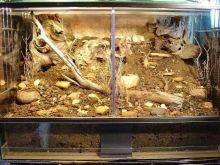


Arrangement
To arrange a home for an exotic animal at home, you will have to take into account many factors.
Lighting
The duration of daylight hours for a reptile should reach 9-14 hours, therefore, additional lighting of the structure at different times of the year has to be done in different ways. For this purpose, ordinary fluorescent lamps operating at a power of 15 to 40 W are suitable. However, their length must correspond to the dimensions of the walls of the structure.
Terrarium reptiles also need ultraviolet light. Its deficiency negatively affects the state of the eggs being laid - their fragility increases, and the state of the bone skeleton of the emerging lizard, on the contrary, worsens. As for adults, metabolic processes are disrupted in their bodies, and the absorption of nutrients is worse. All this suggests that one cannot do without a lamp with ultraviolet radiation in the arrangement of a home, but they must be mounted at a distance of no closer than 60 centimeters from animals.
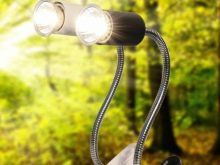


Heating
The issue of heating is decided depending on the characteristics of the terrarium reptile. So, for an animal belonging to a temperate climatic zone, in summer and spring, it will be necessary to provide daytime temperatures from +22 to +27 degrees, as well as night temperatures at +19 degrees. In the autumn and winter months, this interval shifts to plus 18-24 degrees during the day and +16 degrees at night. Tropical lizards can be at a temperature of about +25 degrees at any time of the day all year round.
The required microclimate is provided with the help of special heating elements. We are talking about lamps with a mirror coating and safety nets, which will prevent the animals from injuring their paws or muzzle. Heating stones and rugs are also used.Together with them, a thermometer that controls the temperature is necessarily mounted inside the glass tank.
It is possible to install an automatic regulator that can prevent overheating of the terrarium space.
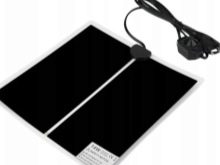


Ventilation and humidity
One wall of the enclosure, or at least part of it, should have ventilation openings. In principle, the holes can be drilled independently in plexiglass, but there is an option with a special wire wall. You can also assemble the sides from wooden slats, and tighten the space between them with a plastic mosquito net. It is better to cover the structure with a metal mesh with many holes. Such a device will not only contribute to ventilation, but also provide a good overview of what is happening inside.
It is also proposed to consider a composite cover, the glass part of which is securely fixed to the walls, and made of wire mesh can be easily opened. The size of the holes is selected depending on the size of both the reptile and the terrarium. If the volume of the tank exceeds 100 liters, then an exhaust fan is additionally installed inside, otherwise its inhabitants will suffocate.
The humidity inside the terrarium should be quite high, at the level of 70-90%, and therefore its contents will need to be sprayed with water on a regular basis. It is most convenient to use an aerosol spray for this purpose. The living plants inside and a small pool will help to increase the indicator.



Plants and soil
It is allowed to plant in the terrarium only those plants that are devoid of thorns, and are also completely non-toxic, which means they are safe for lizards. It is good if they do not have slippery surfaces, and the branches can support the weight of the animal. For example, it could be an epiphyte, also known as tillandsia. Such a culture receives useful substances from the air and a small amount of water, and therefore it develops quite successfully in such unfavorable conditions. Stabilized moss is also suitable for terrarium to help maintain adequate moisture levels. Living moss cannot survive in such an environment.
It is proposed to lay out the bottom with fine gravel, gravel, marble, peat, granite or special coarse sand. If the pet likes to bury itself in the ground, then it is worth providing it with at least a ten-centimeter layer of sandy soil.
Do not use ordinary soil, as, being moistened in a limited space under a light bulb, it will quickly become moldy.

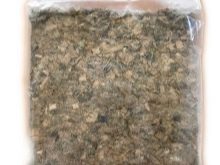
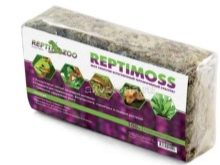
Decor
The decorative elements placed in the terrarium are selected depending on what type of pets are.
- For example, the dwelling of the inhabitants of deserts and semi-deserts can be decorated with sand and stones.
- For the entertainment of the lizards, grottoes and small ceramic caves are organized.
- Fragments of real trees are necessarily placed in the house of arboreal reptiles.
- Your tropical pet will love the small pool of water in which you can swim.
- Such decor as small stones, processed pieces of glass from a broken glass, shards, pots, driftwood or stones is considered universal.











